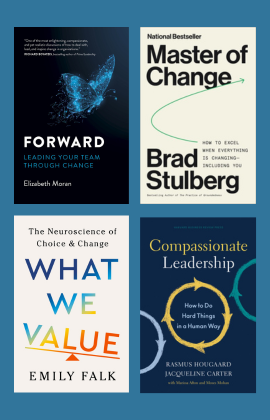
 Change is inevitable – but good gravy, it is coming fast and furious these days! We are being asked to take new directions, do more with less, use AI, be wary of AI, work harder, smarter, faster and remotely (or not), and it’s leaving us feeling like we are standing on shaky ground. Which way do we go? How do we give our teams the support they need while challenging them to respond quickly and positively? At PB4B, we’ve seen a dramatic shift in our client base, and we know firsthand that the ability to adapt to change isn’t just beneficial—it’s essential. While many authors have written about navigating workplace change, these are four influential books that we are reading and relying on. I know that these authors would be great for your workplace as well.
Change is inevitable – but good gravy, it is coming fast and furious these days! We are being asked to take new directions, do more with less, use AI, be wary of AI, work harder, smarter, faster and remotely (or not), and it’s leaving us feeling like we are standing on shaky ground. Which way do we go? How do we give our teams the support they need while challenging them to respond quickly and positively? At PB4B, we’ve seen a dramatic shift in our client base, and we know firsthand that the ability to adapt to change isn’t just beneficial—it’s essential. While many authors have written about navigating workplace change, these are four influential books that we are reading and relying on. I know that these authors would be great for your workplace as well.
Leading with Vision
Elizabeth Moran’s Forward: Leading Your Team Through Change emphasizes that successful change begins with clear direction. Moran argues that leaders must articulate a compelling vision that resonates emotionally with team members. By connecting change initiatives to core values and organizational purpose, leaders create the psychological safety needed for teams to embrace uncertainty.
Personal Adaptability
While organizational change happens collectively, Brad Stulberg’s Master of Change: How to Excel When Everything Is Changing – Including You reminds us that transformation begins at the individual level. Stulberg explores how personal adaptability forms the foundation for broader change initiatives. He suggests that developing resilience, cultivating curiosity, and embracing discomfort are crucial skills for navigating turbulence. When individuals master their relationship with change, teams become more agile.
How We Think About Change
Emily Falk’s What We Value: The Neuroscience of Choice and Change reveals how our brains calculate decisions and how understanding this process can transform our relationship with change. By working with our brain’s “value calculation” rather than against it, Falk shows how we can align choices with our core values, overcome resistance, and even influence others to see differently during times of transition.
The Compassion Component
Perhaps most importantly, Rasmus Hougaard and Jacqueline Carter’s Compassionate Leadership: How to Do Hard Things in a Human Way highlights how empathy transforms change management. Their research demonstrates that leaders who acknowledge the human cost of change—fear, uncertainty, resistance—create more sustainable transformations. By combining high expectations with genuine compassion, leaders build trust that carries organizations through difficult transitions.
Integration Is Key
The wisdom from these thought leaders converges on a central truth: effective change management requires vision, personal resilience, and deep compassion. Organizations that integrate these elements create what Moran calls “change capability”—the institutional muscle memory that turns adaptation from threat to advantage.
As you navigate change in your workplace, remember that transformation isn’t merely something to endure—it’s an opportunity to build more agile, resilient, and human-centered organizations for the future. We would love to help you bring in one (or more!) of these authors to help navigate the changes your company is facing – and put books into the hands of your team members that will help ensure that messages take root and grow over time.



